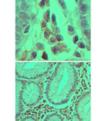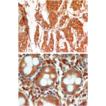Product Details
| Clone: | 31A1067 |
| |
| Host: | Mouse |
| |
| Isotype: | IgG1 |
| |
| Immunogen: | Recombinant human caspase-3. |
| |
| UniProt ID: | P42574 |
| |
| Species reactivity: | Human, Mouse, Rat
|
| |
| Specificity: | Recognizes procaspase-3 and cleaved 17kDa catalytic subunit of caspase-3. Recognizes an epitope in the large (17kDa) domain subunit of caspase-3. |
| |
| Applications: | IHC (FS), IHC (PS), WB
|
| |
| Recommended Dilutions/Conditions: | Western Blot (2-5µg/ml)
Suggested dilutions/conditions may not be available for all applications.
Optimal conditions must be determined individually for each application. |
| |
| Purity Detail: | Protein G-affinity purified. |
| |
| Formulation: | Liquid. In PBS with 0.05% sodium azide. |
| |
| Use/Stability: | Stable for 6 months when stored at +4°C. |
| |
| Handling: | Avoid freeze/thaw cycles. |
| |
| Shipping: | Blue Ice |
| |
| Short Term Storage: | +4°C |
| |
| Long Term Storage: | -20°C |
| |
| Regulatory Status: | RUO - Research Use Only |
| |
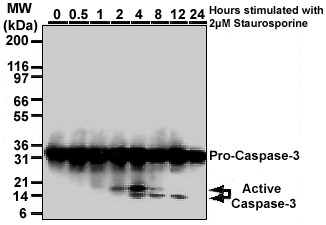
Figure 1: Western blot analysis for detection of Caspase-3 activation in HeLa cells. Cells were treated with 2mM staurosporine for different time periods. Caspase-3 activation is determined by cleavage of procaspase-3, which generates 17 and 12kDa, larger and smaller catalytic subunit, respectively.
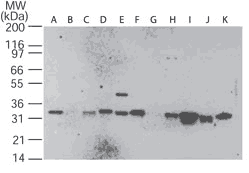
Figure 2: Western blot analysis of Caspase-3 in multiple human tissues using MAb to Caspase-3 (31A1067) (Prod. No.
ALX-804-305) at 2µg/ml. Tissues shown are A) brain, B) heart, C) intestine, D) kidney, E) liver, F) lung, G) muscle, H) stomach, I) spleen, J) ovary, and K) testis."

Figure 3: Western blot analysis of Caspase-3 in A) RAW and B) NIH 3T3 using MAb to Caspase-3 (31A1067) (Prod. No.
ALX-804-305) 2µg/ml."
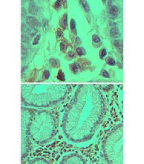
Figure 4: Immunohistochemical analysis of caspase-3 in formalin-fixed, paraffin-embedded human stomach tissue using using MAb to Caspase-3 (31A1067) (Prod. No.
ALX-804-305) at 5 ug/ml. High (top panel) and low magnificaton (bottom panel). Caspase-3 staining is cytoplasmic in some cells and nuclear in others. Caspase-3 in the nucleus is considered to be an indication of active caspase 3. In most cell types and model systems, cells with active caspase-3 are undergoing apoptosis."

Immunohistochemistry analysis: Formalin-fixed, paraffin-embedded human breast cancer (top) and normal colon (bottom) stained with Caspase-3, mAb (31A1067) at 4µg/ml. Localization can be cytoplasmic and nuclear. Staining in the nucleus is considered to be an indication of active Caspase-3. In most cell types and model systems, cells with active Caspase-3 are undergoing apoptosis.
Please mouse over
Product Literature References
Nanobody-based retargeting of an oncolytic herpesvirus for eliminating CXCR4 + GBM cells: A proof of principle: J.S. Gil, et al.; Mol. Ther. Oncolytics
26, 35 (2022),
Abstract;
Tamoxifen induces hepatotoxicity and changes to hepatocyte morphology at the early stage of endocrinotherapy in mice: F. Gao, et al.; Biomed Rep.
4, 102 (2016),
Application(s): Western blot,
Abstract;
Full Text
Interleukin-24 inhibits influenza A virus replication in vitro through induction of toll-like receptor 3 dependent apoptosis: R. Weiss, et al.; Antiviral Res.
123, 93 (2015),
Application(s): Western Blot,
Abstract;
Protective effect of RIP and c-FLIP in preventing liver cancer cell apoptosis induced by TRAIL: J. Sun, et al.; Int. J. Clin. Exp. Pathol.
8, 6519 (2015),
Application(s): Western blot ,
Abstract;
Full Text
2'-hydroxy c16-ceramide induces apoptosis-associated proteomic changes in c6 glioma cells: V. Kota, et al.; J. Proteome Res.
12, 4366 (2013),
Abstract;
Active caspase-3 is removed from cells by release of caspase-3-enriched vesicles: A.N. Böing, et al.; Biochim. Biophys. Acta
1833, 1844 (2013),
Application(s): WB using transfected human breast carcinoma (MCF-7) cell lysates,
Abstract;
Inhibition of vacuolar ATPase attenuates the TRAIL-induced activation of caspase-8 and modulates the trafficking of TRAIL receptosomes: V. Horova, et al.; FEBS J.
280, 3436 (2013),
Abstract;
Multiple effects of the Na+/H+ antiporter inhibitor HMA on cancer cells: F. Aredia, et al.; Apoptosis
18, 1586 (2013),
Abstract;
A possible cross-talk between autophagy and apoptosis in generating an immune response in melanoma: A. Hossain, et al.; Apoptosis
17, 1066 (2012),
Application(s): WB using human melanoma cell lysates,
Abstract;
Full Text
Chondroitin sulphate enhances the antitumor activity of gemcitabine and mitomycin-C in bladder cancer cells with different mechanisms: M. Ferro, et al.; Oncol. Rep.
27, 409 (2012),
Application(s): WB using human bladder carcinoma (HT-1376) cell lysate,
Abstract;
Full Text
Interferon regulatory factor 4 (IRF-4) targets IRF-5 to regulate Epstein-Barr virus transformation: D. Xu, et al.; J. Biol. Chem.
286, 18261 (2011),
Abstract;
NF-kappaB inhibition improves the sensitivity of human glioblastoma cells to 5-aminolevulinic acid-based photodynamic therapy: I. Coupienne, et al.; Biochem. Pharmacol.
81, 606 (2011),
Abstract;
RIP3 expression induces a death profile change in U2OS osteosarcoma cells after 5-ALA-PDT: I. Coupienne, et al.; Lasers Surg. Med.
43, 557 (2011),
Abstract;
Mice lacking dystrophin or alpha sarcoglycan spontaneously develop embryonal rhabdomyosarcoma with cancer-associated p53 mutations and alternatively spliced or mutant Mdm2 transcripts: K. Fernandez, et al.; Am. J. Pathol.
176, 416 (2010),
Abstract;
The prevention of spontaneous apoptosis of follicular lymphoma B cells by a follicular dendritic cell line: involvement of caspase-3, caspase-8 and c-FLIP: J.J. Goval, et al.; Haematologica
93, 1169 (2008),
Application(s): WB using human follicular lymphoma lysate,
Abstract;
Full Text
Protein expression profiling and molecular classification of gastric cancer by the tissue array method: H.S. Lee, et al.; Clin. Cancer Res.
13, 4154 (2007),
Abstract;
Activation of nuclear factor-kappaB contributes to induction of death receptors and apoptosis by the synthetic retinoid CD437 in DU145 human prostate cancer cells: F. Jin, et al.; Cancer Res.
65, 6354 (2005),
Abstract;
Induction of endoplasmic reticulum stress and apoptosis by a marine prostanoid in human hepatocellular carcinoma: P.C. Chiang, et al.; J. Hepatol.
43, 679 (2005),
Abstract;
Induction of endothelial cell apoptosis by lipid hydroperoxide-derived bifunctional electrophiles: W. Jian, et al.; Free Radic. Biol. Med.
39, 1162 (2005),
Abstract;
Justicidin A decreases the level of cytosolic Ku70 leading to apoptosis in human colorectal cancer cells: J.C. Lee, et al.; Carcinogenesis
26, 1716 (2005),
Abstract;
Overexpression of Bcl-2 is associated with apoptotic resistance to the G-quadruplex ligand 12459 but is not sufficient to confer resistance to long-term senescence: C. Douarre, et al.; Nucl. Acids Res.
33, 2192 (2005),
Abstract;
Full Text
Synergism of Rana catesbeiana ribonuclease and IFN-gamma triggers distinct death machineries in different human cancer cells: C.H. Tang, et al.; FEBS Lett.
579, 265 (2005),
Abstract;
Apoptotic proteins in the temporal cortex in schizophrenia: high Bax/Bcl-2 ratio without caspase-3 activation: L.F. Jarskog, et al.; Am. J. Psychiatry
161, 109 (2004),
Abstract;
Hydroxylation at C4’ or C6 is essential for apoptosis-inducing activity of flavanone through activation of the caspase-3 cascade and production of reactive oxygen species: C.H. Ko, et al.; Free Radic. Biol.
36, 897 (2004),
Abstract;
Ricin triggers apoptotic morphological changes through caspase-3 cleavage of BAT3: Y.H. Wu, et al.; J. Biol. Chem.
279, 19264 (2004),
Abstract;
Full Text
Reversal of Taxol resistance in hepatoma by cyclosporin A: involvement of the PI-3 kinase-AKT 1 pathway: H.L. Lin, et al.; Br. J. Cancer
88, 973 (2003),
Abstract;
Emodin induces apoptosis in human promyeloleukemic HL-60 cells accompanied by activation of caspase 3 cascade but independent of reactive oxygen species production: Y.C. Chen, et al.; Biochem. Pharmacol.
64, 1713 (2002),
Abstract;
Identification of a novel synthetic triterpenoid, methyl-2-cyano-3,12-dioxooleana-1,9-dien-28-oate, that potently induces caspase-mediated apoptosis in human lung cancer cells: K.B. Kim, et al.; Mol. Cancer Ther.
1, 177 (2002),
Abstract;
Full Text
The synthetic retinoid CD437 selectively induces apoptosis in human lung cancer cells while sparing normal human lung epithelial cells: S.Y. Sun, et al.; Cancer Res.
62, 2430 (2002),
Abstract;
Full Text
Therapeutic time window of adenovirus-mediated GDNF gene transfer after transient middle cerebral artery occlusion in rat: W.R. Zhang, et al.; Brain Res.
947, 140 (2002),
Abstract;
Identification of retinamides that are more potent than N-(4-hydroxyphenyl)retinamide in inhibiting growth and inducing apoptosis of human head and neck and lung cancer cells: S.Y. Sun, et al.; Cancer Epidemiol. Biomarkers Prev.
10, 595 (2001),
Abstract;
Full Text
Molecular cloning and characterization of Bif-1. A novel Src homology 3 domain-containing protein that associates with Bax: S.M. Cuddeback, et al.; J. Biol. Chem.
276, 20559 (2001),
Abstract;
Full Text
The protein kinase PKB/Akt regulates cell survival and apoptosis by inhibiting Bax conformational change: H. Yamaguchi and H.G. Wang; Oncogene
20, 7779 (2001),
Abstract;












